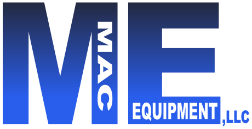Aerial lifts are an essential tool for many construction and industrial projects. They provide a quick and easy way to access hard-to-reach areas for inspections, repairs, installations, and other tasks. Aerial lifts can help you reach areas too high to be safely accessed by a ladder, but there is more to choosing the right lift than size and reach.
Different types of aerial lifts are designed for specific jobs and terrains, and understanding the features and applications of each is important to ensure you make the right purchase or rental. This guide will outline the many considerations you should take when selecting aerial lift equipment for your project.
What Kind of Project Are You Managing?
When selecting an aerial lift, it’s essential to understand the use of the lift and the type of project you are working on. Different aerial lifts have different uses, such as indoor or outdoor work, construction, landscaping, equipment maintenance, film and entertainment, airport maintenance, and more. Here are some common projects that aerial lifts are used for.
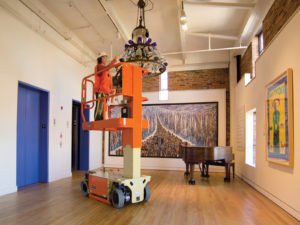 Indoor
Indoor
Indoor projects often require an aerial lift because of the complex architecture and logistics associated with the job. Complex tasks such as painting and decorating, HVAC repair and maintenance, and electrical work all require an aerial lift that can be adjusted to fit the height and width of the space. Various types of lifts are used for indoor work, including scissor lifts, boom lifts, and forklifts.
Scissor lifts are the most popular aerial lift for indoor projects, as they are lightweight, portable, and can be easily adjusted to fit your project needs. Boom lifts are also popular for indoor projects, as they provide a greater reach at heights, allowing people to reach hard-to-access areas.
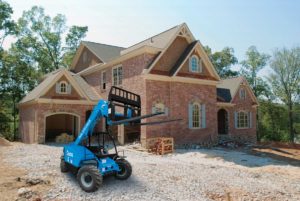
Outdoor
Outdoor projects come in various shapes and sizes, and the type of lift you will need will depend on the project scope and the terrain. Telehandlers are the most popular choice for outdoor projects, as they are designed for heavy-duty off-road performance. Telehandlers can move heavy loads in difficult terrain and across uneven surfaces and are designed to provide a greater lift range.
Boom lifts are also popular for outdoor projects, providing stability and increased flexibility to reach hard-to-reach areas. For construction projects, rough terrain scissor lifts can be a good choice as they can provide stability on uneven surfaces.
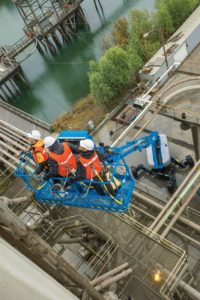
Construction
Construction projects often require an aerial lift to help with tasks inaccessible from the ground. Aerial lifts allow workers to access hard-to-reach areas, such as the second and third stories. Various types of lifts are used for construction projects, including boom lifts and forklifts.
Boom lifts are the most commonly used aerial lifts in the construction industry, as they provide a very high working platform to reach difficult areas. Boom lifts also provide great stability and flexibility, reducing the risk of worker injury or equipment damage. Scissor lifts are also popular in construction, as they provide good stability and can be easily adjusted to fit your project needs.
The Terrain
The terrain you work in is also important when selecting aerial life equipment. Depending on the area, you may need a lift to move through difficult terrain or provide stability and support on an uneven surface. Rough terrain scissor lifts are one option for off-road jobs, as they can move over difficult terrain and are designed for heavy-duty performance.
Rough terrain boom lifts are also an option, as they provide increased reach and can traverse difficult terrain. For indoor jobs, scissor lifts are the best option, as they are light and portable and provide good stability on firm, level surfaces.
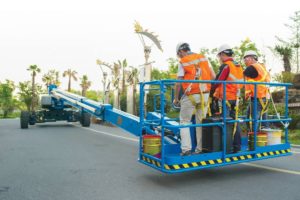
Size of Platform Required / Amount of Personnel and Equipment on Lift
When selecting an aerial lift, it is important to consider the size of the platform and the number of personnel and equipment on the lift. The platform size will vary depending on the aerial lift, so you should consider the project’s size and scope and determine how much space you will need on the platform.
Some lifts can accommodate multiple personnel and equipment, while others may require only one person and a few pieces of equipment to use the lift at a time. Consider how much space you need and how many workers and equipment you need on the platform before purchasing or renting a lift.
Types of Aerial Lifts
Various types of aerial lifts are available, each with unique features and applications. Here are some of the common types of aerial lifts that you might consider for your project:
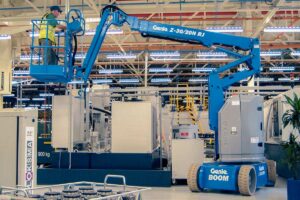 Aerial Lifts
Aerial Lifts
Boom lifts typically have a long arm extending to a certain height and providing access to hard-to-reach areas. The arm is mounted onto a vehicle or base to move from one area to another easily. Common models of aerial lifts include straight and articulated boom lifts.
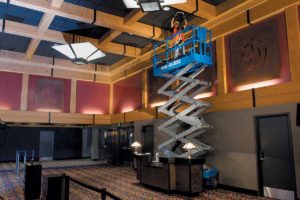
Scissor Lifts
Scissor lifts consist of platforms that move in a scissor-like pattern to lift a person or equipment to a certain height. Scissor lifts are portable, lightweight, and can be moved easily. They are the most commonly used aerial lift for indoor projects, designed to provide stability and flexibility on firm, level surfaces.
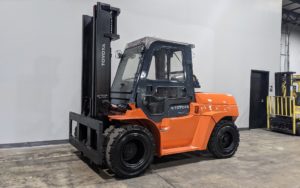 FORKLIFTS
FORKLIFTS
Forklifts are designed to lift heavy loads and are commonly used to move equipment and materials from one area to another. Forklifts are operable by a single person. Forklifts are typically designed to provide good stability and maneuverability.
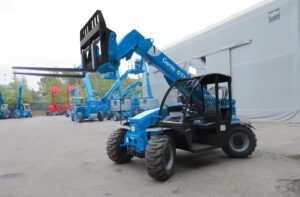
Telehandler
Telehandlers are similar to forklifts and are designed for heavy-duty off-road performance. Unlike standard forklifts, telehandlers have an extendable boom that allows them to pick up and place loads over large distances. They are commonly used in construction and landscaping projects, as they can move heavy loads in difficult terrain.
Conclusion
When selecting aerial lift equipment for your project, it is important to consider the type of job, terrain, size of the platform needed, and amount of personnel and equipment you will be using. Different types of aerial lifts are designed with different features and are best suited for certain projects and terrains.
By understanding the features and applications of each type of lift, you can ensure that you make the right decision for your project.
